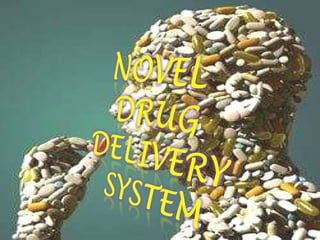Jaideep Sarkar- Buccomucosal Drug Delivery System
- 1. ?
- 2. BMDDS BY : JAIDEEP SARKAR
- 3. Buccomucosal routes of drug delivery involves the delivery of the drug through the mucosal linings of the oral cavity The oral mucosa is composed of 1.outermost layer : stratified squamous epithelium. 2.basement membrane : lamina propria. 3.innermost layer : submucosa. The permeability of buccal mucosa is 4 - 4000 times greater than that of skin. INTRODUCTION
- 4. The cells of the oral epithelia are surrounded by an intercellular ground substance, mucus which is a part of saliva secreted by salivary glands Bioadhesion of mucoadhesive drug delivery systems Cell-cell adhesion Lubrication ENVIRONMENT AND ROLE OF BUCCAL MUCOSA
- 5. Two possible routes of drug absorption through oral mucosa DRUG DELIVERY PATHWAYS
- 6. ?
- 7. Mucoadhesion of the device is a key element The term ¡®mucoadhesive¡¯ is commonly used for materials that bind to the cumin layer of a biological membrane Based on the molecular interactions The molecular interactions composed of attractive and repulsive forces For muco adhesion to occur, the attractive interaction should be larger than repulsions. BUCCAL DRUG DELIVERY AND MUCOADHESIVITY
- 8. ?
- 9. Bioadhesive polymer chains Mucus polymer chains FUSION OF MUCUS LAYER AND BIOADHESIVE POLYMER APPROACHING POLYMERS MECHANISM OF BIOADHESIVE FOR MUCOSAL DRUG DELIVERY
- 10. GENERAL PHYSIOCHEMICAL FEATURES MUCOADHESIVE POLYMERS Predominantly anionic hydrophilicity , suitable surface property, sufficient flexibility Carboxymethyl cellulose Carbopol Polycarbophil Sodium Alginate Hydroxyethyl cellulose Hydroxypropyl methylcellulose Chitosan Gelatin Pectin
- 11. Three types based on their geometry BUCCAL MUCOADHESIVE DOSAGE FORMS
- 12. Drug + Mucoadhesive Matrix ¡¡¡¡¡¡¡¡¡¡¡¡¡¡¡¡¡¡¡¡¡¡¡¡¡ . ¡¡¡¡¡¡¡¡¡¡¡¡¡¡¡¡¡¡¡¡¡¡¡¡¡ . DESIGN OF BUCCAL DOSAGE FORM Matrix type : The Buccal patch designed in a matrix configuration contains drug, adhesive, and additives mixed together Bi-directional patches release drug in both the mucosa and the mouth
- 13. Reserviour type : The buccal patch designed in a reservoir system contains a cavity for the drug and additives separate from the adhesive Impermeable backing is applied to control the direction of drug delivery; to reduce patch deformation and disintegration while in the mouth; and to prevent drug loss Backing Layer Drug + Mucoadhesive Matrix ~~~~~~~~~~~~~~~~~~~~~~~~~~~~~~~~~~~~~~~~~~~~~~~~~~~~~~~~~~~~~~~~ Contd¡
- 14. ACTIVE INGREDIENTS DELIVERED VIA A BUCCAL ROUTE
- 16. Buccal nitroglycerin, is used for acute therapy for an anginal attack as well as for chronic prophylaxis Novel liquid aerosol formulation of insulin Buccal delivery of drugs that undergo a first-pass effect, such as cardiovascular drugs, analgesics, and peptides Promote further research; more companies Rest depend on delivery technology RECENT & FUTURE OF BDDS
- 17. THIS RECENT SCAN IMAGE OF PFIZER PROVES THAT BMDDS HAS SYSTEMIC EFFECT AND SO IS BENEFICIAL FOR THOSE PATIENTS THAT ARE UNCOOPERATIVE FOR OTHER DOSAGE FORM
- 18. Avoids first pass effect, hostility of GIT Abundance of blood vessel, fast cellular recovery Since the formulation is light so less packing cost, transport cost, economy of raw material and cheap Ease of administration and termination Rapid absorption possible & hence relatively rapid onset of action Directly & easily modify microenvironment Lower intersubject variability as compared to transdermal patches as stratum corneum is absent ADVANTAGES
- 19. Relatively small absorptive surface area (0.01 sq m vs 100 sq m for GIT) Movement affects mucoadhesive systems Less permeable than the small intestine Salivation and swallowing Taste of the drug If formulation contains antimicrobial agents, affects the natural microbes in the buccal cavity. The patient cannot eat/drink/speak. DISADVANTAGES
- 20. Buccal drug delivery is a promising area for systemic delivery of orally inefficient drugs as well as an attractive alternative for noninvasive delivery by buccal films, buccal patches, gels and tablets. With the influx of a large number of new drug molecules from drug discovery, mucoadhesive drug delivery will play an even more important role in delivering these molecules. CONCLUSION
- 21. ?





















